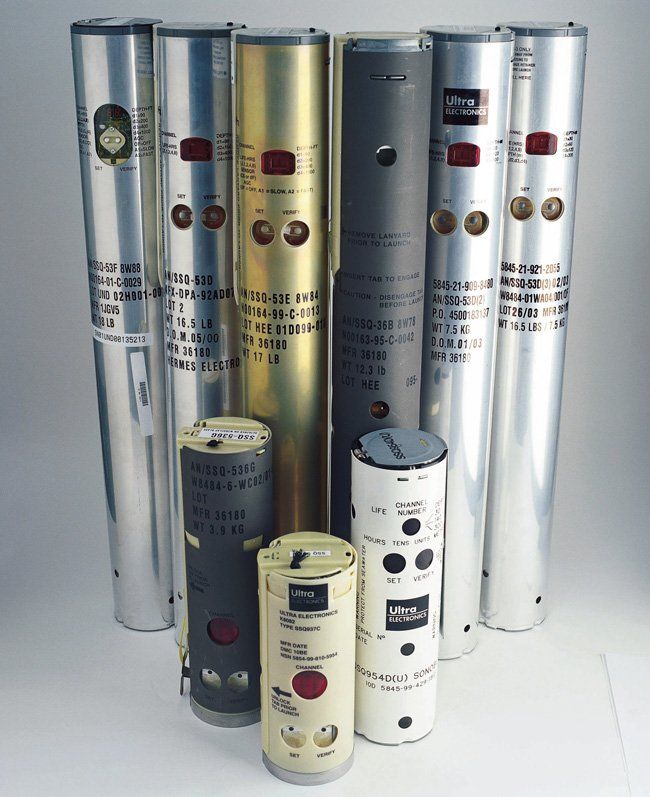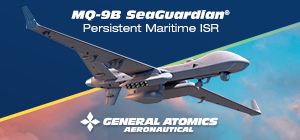
Ultra Maritime has announced the successful completino of the Preliminary Design Review for its new Multistatic Active Receive Sonobuoy (MSARS), a device developed with UK Defence Science and Technology Laboratory (Dstl) funding. The new MSARS sonobuoy is a small form-factor device, in G-size.
Sonobuoys are classified by size with the A-size being the most common and largest, with a diameter of 4.875 inches (12.38 cm), length of 36 inches (91.44 cm) and weight of up to 10 kilograms depending on the payload.
While diameter stays the same, a G-size sonobuoys is much shorter, stopping at 16.5 in (41.9 cm) and generally lighter.
The MSARS compact dimensions are specifically intended to make the new sonobuoy suitable for operation aboard Rotary and Fixed Wing Uncrewed Air Systems which the Royal Navy consider a fundamental component of the future ASW capability, although it will also be compatible with crewed platforms, most notably the MERLIN helicopter.
Ultra’s work includes a patented interface technology to allow the platform’s mission system to directly program sonobuoys prior to launch.
The MSARS work is aligned to the Royal Navy’s PROTEUS rotary wing drone project which sees Leonardo UK currently busy assembling the first demonstrator 3-ton uncrewed helicopter ahead of flight trials in the summer. The Royal Navy hopes that PROTEUS will progress towards an operational capability that will supplement the fleet of MERLIN HM2 helicopters in the ASW role, in Airborne Early Warning and in the movement of cargo.
Royal Navy and Royal Air Force are also interested in the ASW potential of the MQ-9B (PROTECTOR in RAF use) fixed wing UAS, with proposals for its maritime patrol capability to be developed in the 2028 horizon, assuming funding can be secured within the ongoing Strategic Defence Review.
As we reported recently, the Royal Navy ha san ambitious plan (project CABOT) for an “ASW barrier” in the North Atlantic based upon uncrewed platforms.
The development of the new Multistatic Active Receive Sonobuoy is part of a wider project to bring Multistatic ASW capability to the fleet, from sonobuoys up to coordinated frigate-helicopter multistatic sonar search with the Type 23’s towed 2087 sonar and the embarked MERLIN helicopter’s FLASH dipping sonar.
All of these initiatives are grouped under the ASW “SPEARHEAD” program.
Early implementations of multistatic systems have used relatively crude sources - essentially explosive-based – generating one or two pulses of incoherent noise at pre-set depth levels. To achieve the full potential of multistatic search, work has been ongoing to create signal sources that are powered by alternative means and can generate many hundreds or even thousands of coherent pings, the characteristics of which can be programmed to match the operating conditions. In turn, work needs to improve the passive sonobuoys and receivers that listed to the generated echoes, and on the complex multi-channel computer systems to “read” the data.
Ultra, as the sole sonobuoy producer in the UK and the Royal Navy’s strategic supplier, has been working on Multistatic technology and techniques for many years, initially developing the A-size Active Low Frequency Electro-Acoustic source (ALFEA) buoy, which operates in the 1-2kHz frequency range, exploits technology from Ultra's family of sonar countermeasures devices. It incorporates a GPS receiver and can generate a large number of pings (reportedly several hundred) with programmable waveforms. It was originally targeted at the NIMROD MRA4 patrol aircraft.
Development of these systems continued over the years, with additional focus on reducing the sonobuoy size towards the G type. It was back in 2022 that MOD funding was awarded, under Phase 4 of the “Miniaturised Sonobuoy” project, to prototype-build 2 new G-size sonobuoys, the MSARS and an “Enhanced Passive” buoy, both of them optimized to work as receivers working with the G-size ALFEA buoy as active signal generator.
The new sobobuoys at the time were described respectively as “a specialised passive sensing sonobuoy that enhances the existing High Instantaneous Dynamic Range (HIDAR) sonobuoy with an additional wideband transducer” and a “a specialised MSA receiver sonobuoy based on the BARRA” family of passive sonobuoys.
Back in February, Ultra Maritime was awarded a new £18 million contract from the UK Ministry of Defence (MoD) to supply sonobuoys to the Royal Navy’s MERLIN force and also to sustain ongoing development and the increment of in-country production capability. Regarding this last, crucial factor, under Project NODENS Ultra is about to open a new production facility in the London area.








.png)
